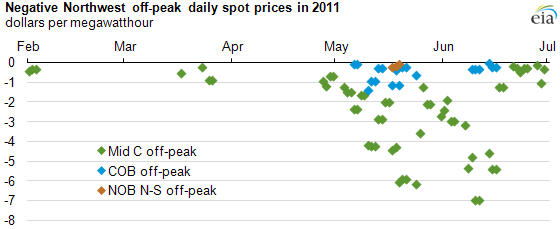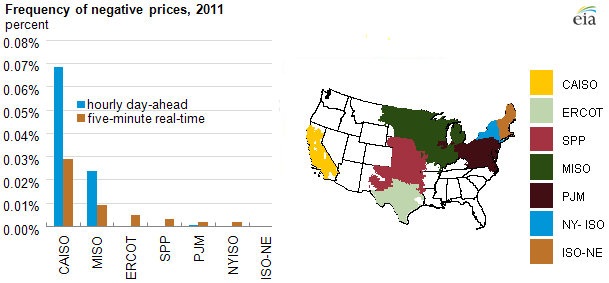Michael Giberson
The Energy Information Administration has published a pair of short posts on negative power prices, one looking at negative prices in bilateral power markets in the Pacific Northwest and another looking at negative prices in RTO markets across the country. Dan Haugen has a related story at Midwest Energy News. Negative power prices may seem counter intuitive, but as Haugen reports negative prices are sometimes just the right price for the market to send.

(Mid-C is the Mid-Columbia pricing point on the Washington-Oregon Boarder; COB is the California-Oregon Border; NOB is the Nevada-Oregon Border)
As the chart above from the bilateral pricing story indicates, negative prices emerged in bilateral trading primarily in May and June. The late Spring 2011 period saw a combination of high hydro power output and high wind power output which overwhelmed the ability of the regional transmission grid (and local consumers) to absorb all the power produced. (See also this related information from EIA.)

Negative prices are uncommon in commodity markets since in effect the producer is paying customers to take away the goods – this is why the often strike power market observers as counter intuitive. The EIA identified the following conditions that lead to emergence of negative prices on power markets:
- For technical and cost recovery reasons, nuclear plant operators try to continuously operate at full power.
- The operation of hydroelectric units reflects factors outside of power demand, for example, compliance with environmental regulations such as controlling water flow to maintain fish populations.
- Eligible renewable generators can take a 2.2 cents/kWh or $22/MWh production tax credit (PTC) on electricity sold. This means that some generators, primarily those operating wind turbines, may be willing to sell their output at negative prices to continue producing power.
- There are maintenance and fuel-cost penalties when operators shut down and start up large steam turbine (usually fossil-fueled) plants as demand varies over a day or a week. These costs may be avoided if the generator sells at a loss when demand is low.
Typically in power markets, these operating or subsidy-driven constraints can be accommodated without negative prices, as other more flexible generating units slow down or cut off to keep energy production and consumption in balance on the system. But when the combination of transmission capability, energy demand, and constrained-on energy production is just wrong, negative prices will be the result.
Considering the four cases above, the first (nuclear) and last (fossil-fueled steam turbine) cases can be distinguished from the second (hydro) and third (subsidized wind) cases. In the nuclear and fossil-fuel cases, the short run negative price is absorbed by the generator as a way to minimize costs and therefore maximize profit over some longer period – as the EIA indicates it can be cheaper to pay someone to take the power than to cycle some large generation units down and then back up again. In both of these cases, if the generator anticipated a long enough string of consecutive negative prices, it would be induced by profit considerations to shut down rather than operate.
Herein is a clear distinction between the nuclear and fossil-fueled generators on the one side and hydro generators on the other: environmental constraints may force a hydro operators to continue operating even in the face of an expectation of a long stream of negative prices. As water enters a dam’s reservoir, it can generate power with it, let the water spill without generation, distribute the water for irrigation or other uses, or hold it in the reservoir. If the last three options are maxed out, the hydro plant must generate power. We can think of negative price in these cases as a kind of shadow price of providing the environmental goods which keep the generator on.
The wind power operator receiving Production Tax Credits or other subsidies will similarly choose to continue operating in the face of a long stream of negative prices, at least so long as the negative price is not so great as to absorb all of the subsidy. But like the first two cases, the wind operator is driven by profit considerations to produce at negative prices. In effect, as the power price drops below the marginal cost of production, the wind power operator is induced to share a portion of the subsidy with consumers taking power from the system.
(I’ve argued before that at least in some cases the subsidies are inducing waste. See additional information. Use this link to see a list of all posts on negative power prices at Knowledge Problem.)